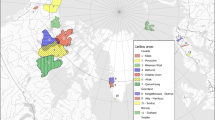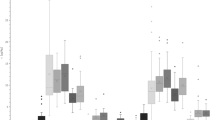Abstract
The concentrations of 11 perfluorinated alkyl acids (PFAAs) were measured in the livers of foxes (Vulpes vulpes) from Germany, a primarily carnivorous species, and chamois (Rupicapra rupicapra) from Austria, an herbivorous species. Perfluorooctanesulfonate (PFOS) at concentrations [all results refer to wet weight (ww)] of 3.2–320 µg/kg were detected in all 40 fox livers tested, yielding an arithmetic mean of 46.6 µg/kg and a median of 29.8 µg/kg. Long-chain PFAAs were detected at concentrations of 1.7 µg/kg perfluorononanoic acid (PFNA) to 2.4 µg/kg perfluorodecanoic acid (PFDA) and perfluorododecanoic acid (PFDoDA). Of the short-chain PFAAs tested, only perfluorohexanoic acid (PFHxA) was found in 1 fox liver at a concentration of 1.4 µg/kg, and perfluorohexane sulfonate (PFHxS) was found in 2 fox livers at a concentration of 1 µg/kg each. PFOS and PFNA concentrations higher than limit of quantification (LOQ) were detected in 90.9 and 81.8 % of chamois livers, respectively. The arithmetic mean for PFOS concentrations was 2.2 µg/kg (median 2.4 µg/kg), a factor of 21 (median factor of 12) lower than in fox livers. The arithmetic mean for PFNA concentrations was 2.0 µg/kg (median 1.9 µg/kg). Perfluorobutanoic acid, PFHxA, perfluorooctanoic acid, perfluorobutanesulfonate, and PFHxS were not detected at concentrations higher than the LOQ in any of the samples. The various results are compared with one another and with the results of other studies of herbivorous, carnivorous, and omnivorous wild animals. The highest concentrations of PFAA, in particular PFOS, were found in omnivorous animals followed by carnivores. The lowest levels were present in herbivores.


Similar content being viewed by others
References
Aas CB, Fuglei E, Herzke D, Yoccoz NG, Routti H (2014) Effect of body condition on tissue distribution of perfluoroalkyl substances (PFASs) in Arctic fox (Vulpes lagopus). Environ Sci Technol 48:11654–11661
Anastassiades M, Lehotay SJ, Stajnbaher D, Schenck FJ (2003) Fast and easy multiresidue method employing acetonitrile extraction/partitioning and "dispersive solid-phase extraction" for the determination of pesticide residues in produce. J AOAC Int 86(2):412–431
Bachour G, Failing K, Georgii S, Elmadfa I, Brunn H (1998) Species and organ dependence of PCB contamination in fish, foxes, roe deer and humans. Arch Environ Contam Toxicol 35:666–673
Baubet E, Bonenfant C, Brandt S (2004) Diet of the wild boar in the French Alps. Galemys S16:101–113
Brunn H, Berlich HD, Müller FJ (1985) Residues of pesticides and polychlorinated biphenyls in game animals. Bull Environ Contam Toxicol 43:527–532
Buck RC, Franklin J, Berger U, Conder JM, Cousins IT, de Voogt P et al (2011) Perfluoroalkyl and polyfluoroalkyl substances in the environment: terminology, classification, and origins. Integr Environ Assess Manag 7:513–541
Conder JM, Hoke RA, de Wolf W, Russell MH, Buck RC (2008) Are PFCAs bioaccumulative? A critical review and comparison with regulatory criteria and persistent lipophilic compounds. Environ Sci Technol 42:995–1003
Cui L, Zhou QF, Liao CY, Fu JJ, Jiang GB (2009) Excretion of PFOA and PFOS in male rats during a subchronic exposure. Arch Environ Contam Toxicol 56:338–349
Dixon WJ (1993) BMDP statistical software and manual. University of California Press, California
Falandysz J, Taniyasu S, Yamashita N, Rostkowski P, Zalewski K, Kannan K (2007) Perfluorinated compounds in some terrestrial and aquatic wildlife species from Poland. Environ Sci Health A 42:715–719
Falk S, Brunn H, Schröter-Kermani C, Failing K, Georgii S, Tarricone K et al (2012) Temporal and spatial trends of perfluoroalkyl substances in liver of roe deer (Capreolus capreolus). Environ Pollut 172:1–8
Gallo V, Leonardi G, Genser B, Lopez-Espinosa MJ, Frisbee SJ, Karlsson L et al (2012) Serum perfluorooctanoate (PFOA) and perfluorooctane sulfonate (PFOS) concentrations and liver function biomarkers in a population with elevated PFOA exposure. Environ Health Perspect 120:655–660
Gannon SA, Johnson T, Nabb DL, Serex TL, Buck RC, Loveless E (2011) Absorption, distribution, metabolism, and excretion of [1-14C]-perfluorohexanoate ([14C]-PFHx) in rats and mice. Toxicology 283:55–62
Georgii S, Bachour G, Failing K, Eskens U, Elmadfa I, Brunn H (1994) PCB congeners in foxes in Germany from 1983 to 1991. Arch Environ Contam Toxicol 26:1–6
Giesy JP, Kannan K (2001) Global distribution of perfluorooctane sulfonate in wildlife. Environ Sci Technol 35:1339–1342
Haukås M, Berger U, Hop H, Gulliksen B, Gabrielsen GW (2007) Bioaccumulation of per- and polyfluorinated alkyl substances (PFAA) in selected species from the Barents Sea food web. Environ Pollut 148:360–371
Hoshi H, Minamoto N, Iwata H, Shiraki K, Tatsukawa R, Tanabe S et al (1998) Organochlorine pesticides and polychlorinated biphenyl congeners in wild terrestrial mammals and birds from Chubu region, Japan: interspecies comparison of the residue levels and compositions. Chemosphere 36(15):3211–3221
Jędrzejewski W, Jędrzejewska B (1992) Foraging and diet of the red fox Vulpes vulpes in relation to variable food resources in Białowieża National Park, Poland. Ecography 15:212–220
Klansek E (2004) Nahrungszusammensetzung von Rot-, Reh-, und Gamswild im Berggebiet. Tagung für die Jägerschaft, Bundesanstalt für alpenländische Landwirtschaft Gumpenstein 16–17(02)
Kowalczyk J, Ehlers S, Fuerst P, Schafft H, Lahrssen-Wiederholt M (2012) Transfer of perfluorooctanoic acid (PFOA) and perfluorooctane sulfonate (PFOS) from contaminated feed into milk and meat of sheep: pilot study. Arch Environ Contam Toxicol 63(2):288–298
Kunacheva C, Fujii S, Tanaka S, Seneviratne ST, Lien NP, Nozoe M et al (2012) Worldwide surveys of perfluorooctane sulfonate (PFOS) and perfluorooctanoic acid (PFOA) in water environment in recent years. Water Sci Technol 66(12):2764–2771
Leckie FM, Thirgood SJ, May R, Redpath SM (1998) Variation in the diet of red foxes on Scottish moorland in relation to prey abundance. Ecography 21:599–604
Martin JW, Asher BJ, Beesoon S, Benskin JP, Ross MS (2010) PFOS or PreFOS? Are perfluorooctane sulfonate precursors (PreFOS) important determinants of human and environmental perfluorooctane sulfonate (PFOS) exposure? J Environ Monit 12(11):1979–2004
Meinel K (2008) Eine Feldstudie am Schwarzwild zum Einsatz von Ammonium-eisenhexacyanoferrat zur Reduzierung der Radiocäsiumbelastung. Schr Landesjagdverb Bayern 15
Müller CE, De Silva AO, Small J, Williamson M, Wang X, Morris A et al (2011) Bioagmnification of perfluorinated compounds in a remote terrestrial food chain: lichen–caribou–wolf. Environ Sci Technol 45:8665–8673
Olsen GW, Chang SC, Noker PE, Gorman GS, Ehresman DJ, Lieder PH et al (2009) A comparison of the pharmacokinetics of perfluorobutanesulfonate (PFBS) in rats, monkeys, and humans. Toxicology 256:65–74
Prevedouros K, Cousins IT, Buck RC, Korzeniowski SH (2006) Sources, fate and transport of perfluorocarboxylates. Environ Sci Technol 40:32–44
Schley L, Roper TJ (2003) Diet of wild boar Sus scrofa in Western Europe, with particular reference to consumption of agricultural crops. Mamm Rev 33(1):43–56
Shi Y, Wang J, Pan Y, Cai Y (2012) Distribution of perfluorinated compounds in water, sediment, biota and floating plants in Baiyangdian Lake, China. J Environ Monit 14(2):636–642
Stahl T, Falk S, Failing K, Berger J, Georgii S, Brunn H (2012) Perfluorooctanoic acid and perfluorooctane sulfonate in liver and muscle tissue from wild boar in Hesse, Germany. Arch Environ Contam Toxicol 62:696–703
Tomza-Marciniak A, Marciniak A, Pilarczyk B, Prokulewicz A, Bąkowska M (2014) Interspecies comparison of chlorinated contaminant concentrations and profiles in wild terrestrial mammals from northwest Poland. Arch Environ Contam Toxicol 66:491–503
Young CJ, Mabury SA (2010) Atmospheric perfluorinated acid precursors: chemistry, occurrence, and impacts. Rev Environ Contam Toxicol 208:1–109
Acknowledgments
The authors thank Rosa Maria Sobel for measurements of the samples. We also thank Barbara Gamb for assistance in the literature search. Special thanks go to Rudolf Tinneberg for providing the chamois liver samples and to the hunters from Hesse, Germany, who provided the fox samples. We are indebted to veterinary pathologist Anne Nessler and her team for extraction and portioning of the fox livers for PFAA analysis.
Author information
Authors and Affiliations
Corresponding author
Rights and permissions
About this article
Cite this article
Riebe, R.A., Falk, S., Georgii, S. et al. Perfluoroalkyl Acid Concentrations in Livers of Fox (Vulpes vulpes) and Chamois (Rupicapra rupicapra) from Germany and Austria. Arch Environ Contam Toxicol 71, 7–15 (2016). https://doi.org/10.1007/s00244-015-0250-8
Received:
Accepted:
Published:
Issue Date:
DOI: https://doi.org/10.1007/s00244-015-0250-8




